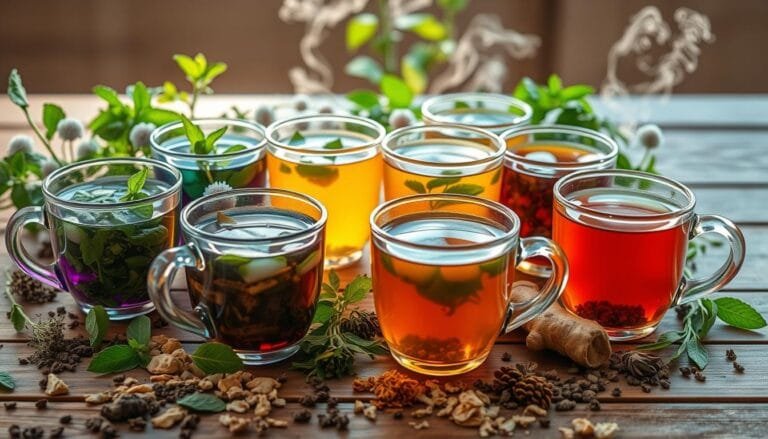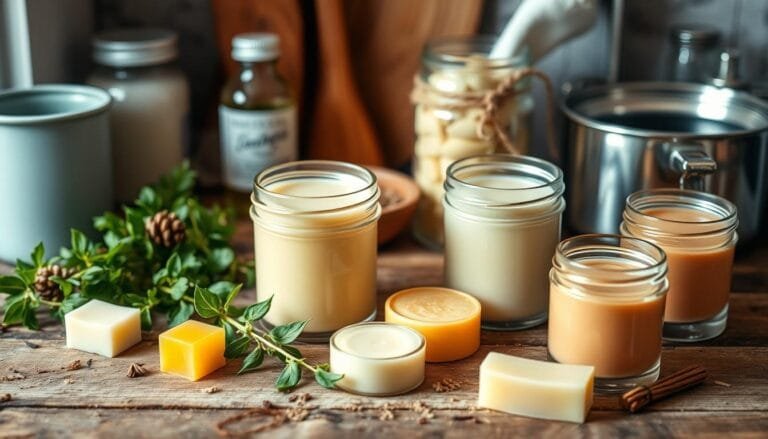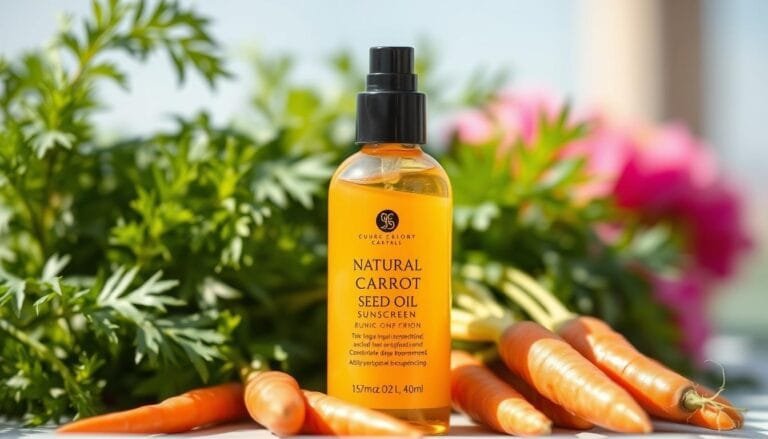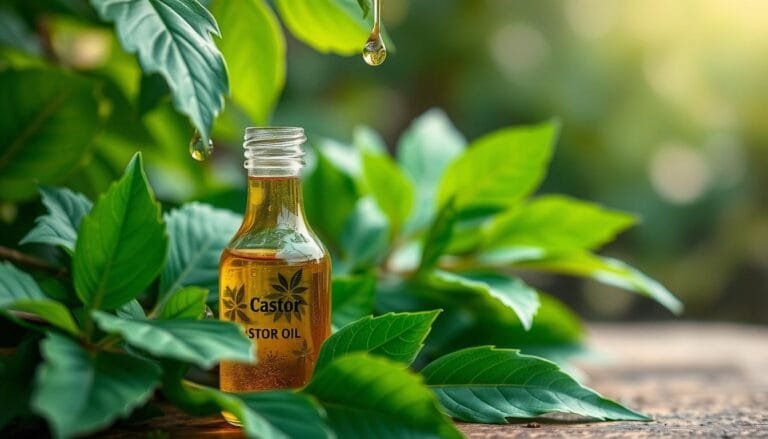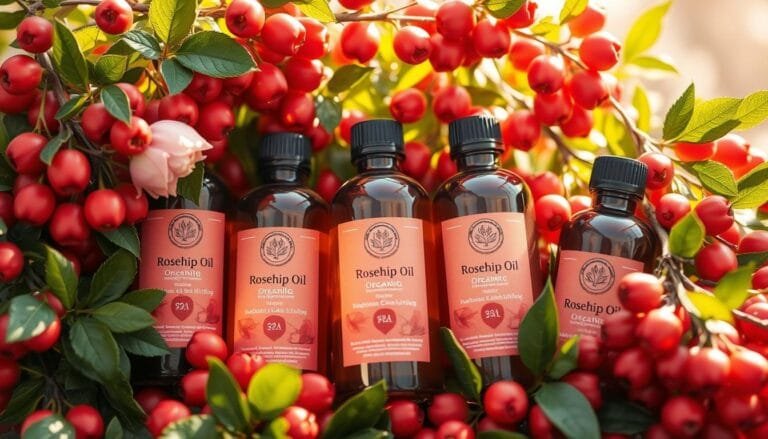I’ve always been interested in natural remedies, and echinacea is one that caught my eye. This flowering plant from North America is known for boosting the immune system and easing cold symptoms. It’s been used for centuries by Native American tribes and is now popular worldwide.
The science on echinacea for colds is a bit mixed. Some studies show it works well, while others are less clear. But I think it’s worth trying as a natural way to fight colds. In this guide, we’ll look at the science, how to use it, and how to pick the best products.
If you want to prevent or ease colds naturally, echinacea is worth a try. It’s important to know its benefits and risks, and how to use it right. Let’s dive into echinacea and see if it can be a natural cold remedy.
Understanding Echinacea: A Traditional Medicinal Plant
Echinacea, also known as the purple coneflower, has a long history in Native American medicine. For over 400 years, it has been used to treat many ailments. Today, it’s a top herbal supplement worldwide, known for boosting the immune system and reducing inflammation.
Native American Heritage and Historical Use
The use of echinacea purpurea, echinacea angustifolia, and echinacea pallida is rooted in Native American culture. These species are key in herbal remedies and supplements. Tribes like the Lakota, Cheyenne, and Pawnee used echinacea for snakebites, burns, and respiratory problems.
Different Species of Echinacea
There are nine echinacea species, but only a few are used for medicine. The most well-known include:
- Echinacea purpurea (Eastern Purple Coneflower)
- Echinacea angustifolia (Narrow-Leaf Coneflower)
- Echinacea pallida (Pale Purple Coneflower)
Active Components and Properties
Echinacea plants have many active compounds. These include polysaccharides, glycoproteins, alkamides, volatile oils, and flavonoids. These help with immune support and reducing inflammation. It also has antioxidants like cichoric acid and rosmarinic acid, making it great for a healthy lifestyle.
The Science Behind Echinacea’s Immune-Boosting Effects
Echinacea is a plant known for boosting the immune system and helping with colds. But what does science say about it? Many studies have looked into how echinacea works.
Echinacea is thought to help by making more white blood cells. These cells are key in fighting off infections. Studies show echinacea might help make certain immune cells, like natural killer cells, to fight off invaders.
Echinacea also has antiviral properties. It has compounds like caffeic acid derivatives and alkamides. These might stop viruses from multiplying, helping with viral infections like the common cold.
Also, echinacea might have anti-inflammatory effects. It could help control inflammation, reducing swelling and discomfort in health issues like colds and respiratory problems.
“Echinacea has been recognized for its medicinal properties for centuries by Native American tribes, who used it to treat various ailments.”
While studies show echinacea might be helpful, more research is needed. It’s important to understand how it works and its effectiveness. Yet, its ability to support the immune system and offer natural relief is intriguing to many.

| Key Findings on Echinacea’s Immune-Boosting Effects |
|---|
|
Using Echinacea for Colds: Dosage and Timing
When using echinacea for colds, timing and dosage matter a lot. Experts say to start echinacea when you first feel cold symptoms. This helps your body fight off the cold better.
When to Start Taking Echinacea
Start taking echinacea when you first notice cold symptoms. This could be a sore throat, sniffles, or feeling generally unwell. It helps your body’s defenses and might make your cold symptoms less severe and shorter.
Recommended Daily Intake
- Most studies show that 450-4,000 mg of echinacea a day works well.
- Take echinacea with food or a big glass of water, not on an empty stomach.
Duration of Treatment
Echinacea for colds is usually taken for up to 10 days. But, some experts say not to use it for more than 8 weeks. They’re not sure about the long-term effects of taking echinacea for a long time.
| Echinacea Dosage for Cold Treatment | Duration of Use |
|---|---|
| 450-4,000 mg per day | Up to 10 days, not exceeding 8 weeks |
Always talk to a healthcare professional before starting any new herbal supplement. This is very important if you have health issues or are taking medicines.
Available Forms and Preparations of Echinacea
Echinacea is a popular herbal supplement available in many forms. You can find it as tea, capsules, or tinctures. Each option offers a way to enjoy the immune-boosting benefits of this plant.
Echinacea tea is a favorite, with up to 1,000 mg of root per serving. It’s a natural way to add this herb to your daily routine, perfect for cold and flu season.
For a stronger dose, try echinacea capsules. They come in different parts of the plant, each with its own active compounds.
Liquid extracts, or tinctures, are another popular choice. They are concentrated and easy to take by the dropper. This form quickly delivers the herb’s active ingredients.
Echinacea is also found in combination products. These include it with vitamin C or elderberry. These blends aim to boost your health even more.
When choosing echinacea, pick high-quality products from trusted brands. Always talk to a healthcare professional before adding it to your routine.
| Echinacea Product | Typical Dosage | Potency Range | Average Cost |
|---|---|---|---|
| Echinacea Tea | 1-2 cups per day | Up to 1,000 mg of root per serving | $8 – $12 for 20-30 servings |
| Echinacea Capsules | 300-500 mg, 1-3 times per day | 300-500 mg per capsule | $10 – $17 for a 30-day supply |
| Echinacea Tinctures | 30-60 drops, 1-3 times per day | Varies by brand, typically 1:2 or 1:4 ratio | $12 – $20 for a 1-2 oz bottle |
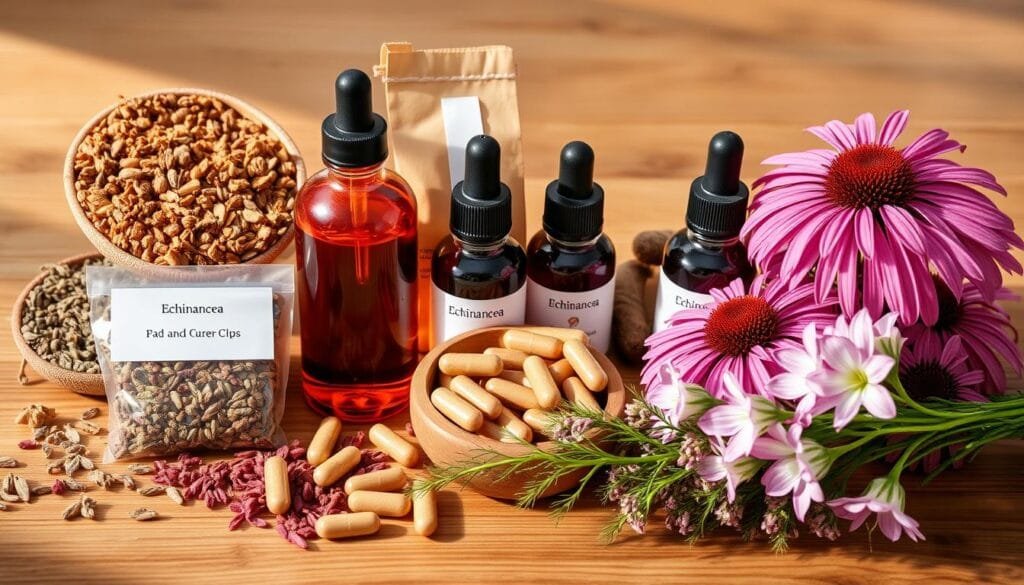
“Echinacea is one of the top-selling herbs in the United States for the treatment of upper respiratory infections.”
Clinical Research and Effectiveness Studies
Research on echinacea for colds shows mixed results. Some studies say it can shorten colds by 1 to 4 days and lessen symptoms. But, other studies found no real benefits in preventing or treating colds.
Impact on Cold Duration
A review of 14 studies showed echinacea might cut cold risk by 58%. Yet, a large review of 24 studies found no real difference in preventing cold symptoms between echinacea and placebo.
Prevention vs Treatment
Studies are split on echinacea’s role in preventing or treating colds. A review showed a 10% to 20% risk reduction in prevention studies. But, only 2 out of 6 treatment trials found echinacea significantly reduced cold duration.
Scientific Evidence Overview
A detailed review of 24 double-blind trials with 4,631 participants was done. It found 10 trials had low bias risk. But, there was no significant difference in dropout rates or adverse effects between echinacea and placebo.
Yet, a trend showed more dropouts due to side effects in echinacea groups in prevention trials.
“Variability in data was noted as higher than expected, limiting the power to detect small but potentially important benefits.”
In summary, echinacea’s effectiveness for colds is not clear. More high-quality studies are needed to understand its true benefits.
Selecting High-Quality Echinacea Products
Choosing the right echinacea supplement is key for cold relief. Look for products from trusted brands that have been tested by third parties. These should also have standardized extracts.
Echinacea is a favorite herb in America, but its use has dropped with antibiotics. Yet, German studies show it boosts the immune system, eases pain, and fights inflammation. It can also cut cold risk by 58% and shorten colds by 1 to 4 days.
A study by ConsumerLab.com showed only 4 out of 11 echinacea products met label claims. This stresses the need for high-quality, standardized echinacea extracts from reputable brands that have been third-party tested. These steps ensure the product’s potency and safety.
“Among the Echinacea supplements tested, four products did not meet the expected minimum amounts of total phenolic compounds, with one having less than 2%.”
When buying echinacea supplements, check the product’s details. Look for the echinacea species, extraction method, and active compound levels. Studies support using aerial parts of Echinacea purpurea or roots of Echinacea angustifolia.
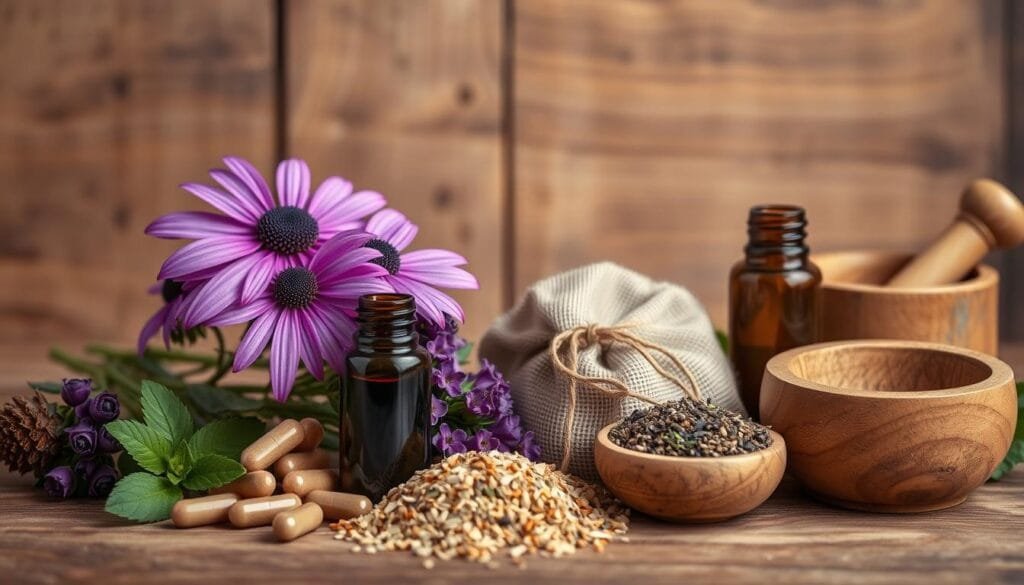
By picking high-quality, standardized echinacea from trusted brands, you get a reliable product. It supports your immune system during cold season.
Potential Side Effects and Safety Considerations
Echinacea is usually safe and well-tolerated. But, it’s important to know about possible side effects and safety tips. Echinacea side effects might include stomach upset, nausea, diarrhea. You might also feel dizziness, dry eyes, or get a skin rash. Rarely, some people might have allergic reactions, mainly if they’re allergic to daisy family plants.
Some groups should not take echinacea. This includes people with autoimmune diseases, tuberculosis, leukemia, or liver problems. Pregnant women and young kids should also be careful. It’s key to talk to a doctor before starting echinacea, if you have health issues or take medicines.
Common Side Effects of Echinacea
- Stomach upset
- Nausea
- Diarrhea
- Dizziness
- Dry eyes
- Skin rash
Risk Groups and Contraindications
- Autoimmune disorders
- Tuberculosis
- Leukemia
- Liver disorders
- Pregnant women
- Young children
Be careful and talk to a doctor before using echinacea. This is true if you have health issues or take medicines. Also, make sure to store and check the quality of echinacea supplements properly.
Combining Echinacea with Other Cold Remedies
Many people use natural remedies like echinacea to fight the common cold. Echinacea works better when mixed with other ingredients. This mix of herbal combinations, vitamin C, zinc, and elderberry can boost your immune system and help with cold symptoms.
Research has looked into using echinacea with other natural cold remedies. But, we need more studies to know for sure if these mixes are safe and work well. Here’s a look at some common echinacea-based cold remedy blends:
- Echinacea and Vitamin C: Vitamin C is great for your immune system. Echinacea and vitamin C together might help you feel better faster.
- Echinacea and Zinc: Zinc is important for your immune health. Echinacea and zinc might make cold symptoms less severe and shorter.
- Echinacea and Elderberry: Elderberry fights viruses and reduces inflammation. It pairs well with echinacea to protect against colds and flu.
These mixes might offer extra benefits, but be careful and talk to a doctor, mainly if you’re on meds. The right amount and timing of echinacea with other remedies are important.
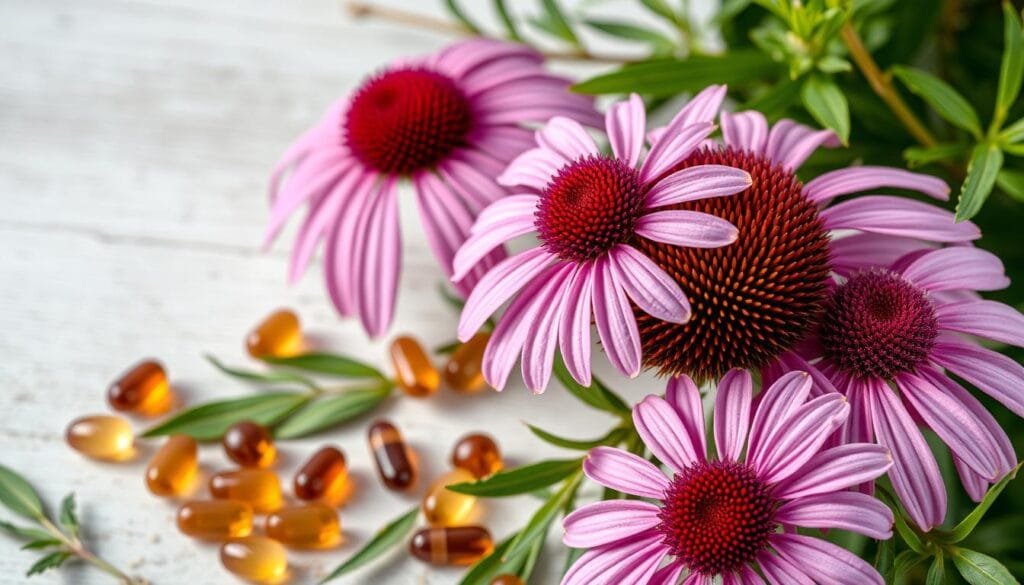
The success of echinacea-based cold remedy blends varies. It depends on the person, the mix, and how bad the cold is. Knowing the good and bad of these natural combinations helps you choose the best for your body during cold and flu season.
Special Considerations for Children and Pregnant Women
Using echinacea needs extra care for kids and pregnant women. It’s usually safe, but there are key things to think about for these groups.
For kids, choose alcohol-free echinacea. Alcohol can harm young bodies. A doctor or herbalist should decide the right dose based on the child’s age and size.
When it comes to pregnancy, the research is limited but promising. A study showed no extra risks of early birth, low birth weight, or small babies. But, animal studies suggest it might raise the risk of miscarriage.
For breastfeeding moms, some studies found echinacea in breast milk. The impact on babies is unknown, so caution is wise. Pregnant and breastfeeding women should talk to their doctors before trying echinacea.
Because there’s not much research on echinacea in kids and pregnant women, they should be careful. Always get advice from a healthcare professional before using it.
| Consideration | Recommendation |
|---|---|
| Children | Use alcohol-free preparations, consult pediatrician for dosage |
| Pregnancy | Limited evidence suggests generally safe, but caution advised |
| Breastfeeding | Echinacea components found in breast milk, consult healthcare provider |
Drug Interactions and Precautions
It’s key to know about possible drug interactions with echinacea. This herb might affect how certain drugs work. Always talk to your doctor before adding it to your routine, if you’re on prescription meds.
Echinacea might make immunosuppressant drugs less effective. These drugs help with conditions like rheumatoid arthritis and organ transplant rejection. Echinacea boosts the immune system, which could undo the drugs’ purpose.
Echinacea could also change how caffeine works in your body. This means it might make caffeine, found in coffee and tea, stronger. If you’re taking echinacea, watch your caffeine intake closely.
But, echinacea might make some antifungal drugs work better. This could be good for people using these drugs. Just make sure to talk to your doctor about it to avoid any problems.
If you’re on prescription meds, like those for surgery or to suppress the immune system, see your doctor first. They’ll check if echinacea is safe for you. It’s important to review all your medications, including over-the-counter and herbal ones, to avoid any bad interactions.
| Potential Interaction | Possible Effect | Recommendation |
|---|---|---|
| Immunosuppressants | Reduced effectiveness | Consult healthcare provider before use |
| Caffeine-containing products | Increased effects | Monitor caffeine intake |
| Antifungal agents (e.g., econazole) | Enhanced potency | Discuss with healthcare provider |
Even though echinacea is natural, it’s not risk-free. Always talk to a healthcare professional before using it, to make sure it’s safe and works well with your other meds.
Natural Alternatives and Complementary Treatments
Echinacea has shown promise in fighting colds, but it’s not the only option. Other herbal remedies like elderberry, zinc, and vitamin C are also worth trying. Garlic and honey are popular choices too. Some people use essential oils like eucalyptus and lemon for relief.
Combining herbal remedies with good nutrition, rest, and hydration can help a lot. Zinc lozenges and vitamin C supplements might shorten colds if taken early. Garlic can lower cold risk, and honey soothes coughs and sleep issues in kids.
Finding the right cold remedy is all about trial and error. It’s about finding what works for you. By trying different herbal remedies and treatments, I can create a cold-fighting plan that suits me.
FAQ
What is echinacea, and how has it been used historically?
What are the active components and properties of echinacea?
How does echinacea work to support the immune system?
When is the best time to start taking echinacea, and what are the recommended dosages?
What are the different forms of echinacea available, and how do they differ?
What does the research say about the effectiveness of echinacea for colds?
How can I choose high-quality echinacea supplements?
What are the potentially side effects and safety considerations for using echinacea?
Can echinacea be combined with other natural cold remedies?
Are there any special considerations for using echinacea in children and pregnant women?
Can echinacea interact with medications?
Source Links
- https://www.webmd.com/cold-and-flu/echinacea-common-cold
- https://www.healthline.com/nutrition/echinacea-for-colds
- https://www.healthline.com/nutrition/echinacea
- https://www.webmd.com/vitamins/ai/ingredientmono-981/echinacea
- https://health.clevelandclinic.org/echinacea
- https://www.webmd.com/diet/health-benefits-echinacea
- https://www.nottingham.ac.uk/biosciences/documents/burn/2006/echinacea-and-the-immune-system–juliet-parker.pdf
- https://my.clevelandclinic.org/health/drugs/19313-echinacea-oral-dosage-forms
- https://www.rxlist.com/supplements/echinacea.htm
- https://www.aafp.org/pubs/afp/issues/2003/0101/p77.html
- https://www.cancerresearchuk.org/about-cancer/treatment/complementary-alternative-therapies/individual-therapies/echinacea
- https://pmc.ncbi.nlm.nih.gov/articles/PMC3056276/
- https://www.cochranelibrary.com/cdsr/doi/10.1002/14651858.CD000530.pub3/full
- https://www.mountsinai.org/health-library/herb/echinacea
- https://www.consumerlab.com/reviews/echinacea-review/echinacea/
- https://www.verywellhealth.com/echinacea-benefits-side-effects-and-more-7503379
- https://www.rxlist.com/echinacea/generic-drug.htm
- https://www.health.com/echinacea-benefits-7570763
- https://pmc.ncbi.nlm.nih.gov/articles/PMC4068831/
- https://www.ncbi.nlm.nih.gov/books/NBK582687/
- https://www.babycenter.com/pregnancy/diet-and-fitness/is-it-safe-to-take-echinacea-during-pregnancy_1246878
- https://www.webmd.com/drugs/2/drug-17230/echinacea-herb-oral/details
- https://pmc.ncbi.nlm.nih.gov/articles/PMC3024156/
- https://www.verywellhealth.com/cold-remedies-90007
- https://www.cochrane.org/CD000530/ARI_echinacea-for-preventing-and-treating-the-common-cold

